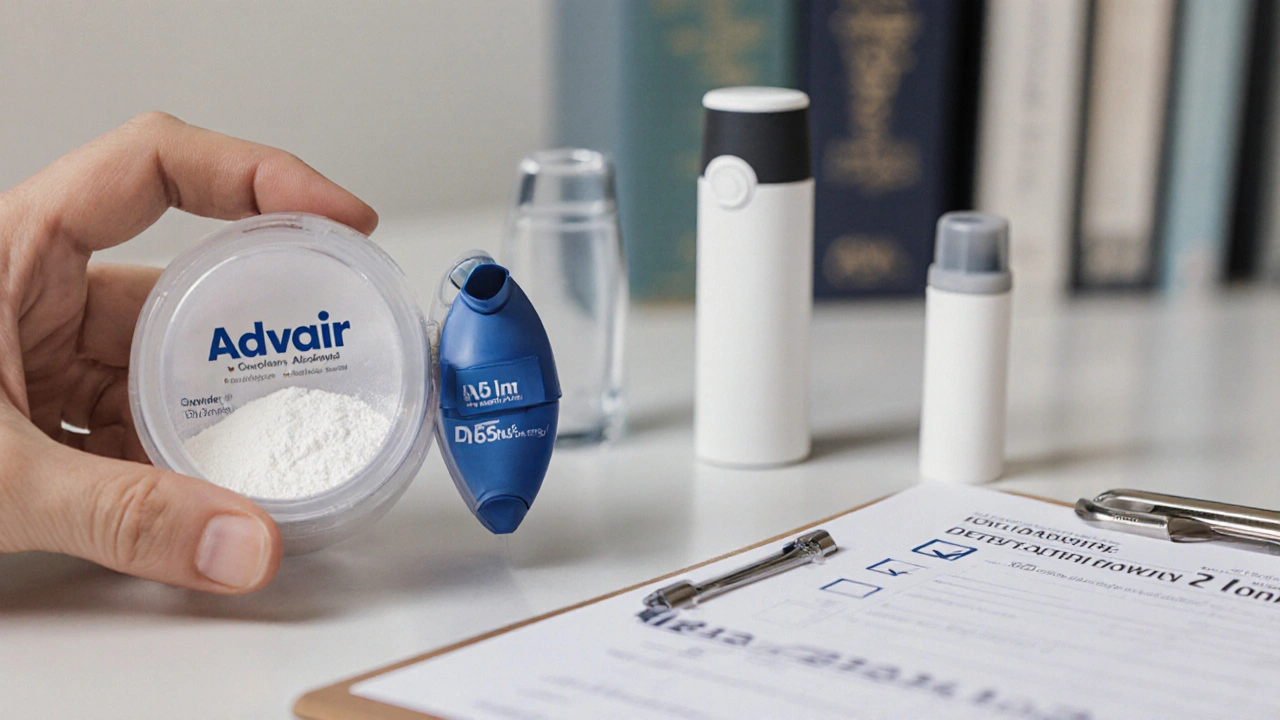Inhaler Comparison Tool
Select Your Condition
Device Preference
Dosing Frequency
Budget Consideration
Recommended Inhaler
Details
| Inhaler | Active Ingredients | Device Type | Dosage | Cost (AUD) |
|---|
When it comes to controlling asthma or COPD, Advair Diskus is often the first name that pops up. It combines a corticosteroid (fluticasone propionate) with a long‑acting beta2‑agonist (salmeterol) in a dry‑powder inhaler, delivering both anti‑inflammatory and bronchodilator effects with each breath.
TL;DR
- Advair Diskus = fluticasone+salmeterol, dry‑powder inhaler.
- Key alternatives: Symbicort, BreoEllipta, Dulera, TrelegyEllipta, generic fluticasone/salmeterol.
- Compare on device type, dosing frequency, cost, and side‑effect profile.
- For pure asthma, combo inhalers work best; for COPD with a component of asthma, consider triple therapy like Trelegy.
- Check insurance coverage in Australia; many alternatives are cheaper than the brand‑name Advair.
How Advair Diskus Works
Advair Diskus is a combination inhaler that delivers 100µg of fluticasone propionate (a corticosteroid) and 50µg of salmeterol (a long‑acting beta2‑agonist) per inhalation. The dry‑powder device releases a consistent dose when the patient opens the device to its “twist‑to‑unlock” position and inhales quickly.
The steroid reduces airway inflammation, while the beta‑agonist relaxes smooth muscle, keeping the airways open for up to 12hours. This dual action makes it suitable for maintenance therapy in both moderate‑to‑severe asthma and COPD.
Decision Criteria for Choosing an Inhaler
Before we jump into the side‑by‑side chart, consider what matters most to you or your prescriber:
- Device type: Dry‑powder vs. metered‑dose vs. soft‑mist. Patient dexterity and inspiratory flow affect performance.
- Dosing frequency: Once daily is convenient; twice‑daily may offer tighter control for some.
- Medication combo: Do you need just a steroid, just a bronchodilator, or both? Some patients benefit from a triple combo (steroid+LABA+LAMA).
- Cost & insurance: Brand‑name prices in Australia can be steep; generics and bulk‑billing schemes matter.
- Side‑effect profile: Local oral thrush, hoarseness, or systemic steroid effects differ between devices.
Comparison Table of Popular Alternatives
| Inhaler | Active ingredients | Device type | Approved for | Dose strength | Typical cost (AU$) | Pros | Cons |
|---|---|---|---|---|---|---|---|
| Advair Diskus | Fluticasone propionate+Salmeterol | Dry‑powder (Diskus) | Asthma, COPD | 100µg+50µg (twice daily) | ~AU$120 per pack (30 doses) | Well‑studied; twice‑daily dosing gives flexibility. | Higher out‑of‑pocket cost; requires strong inspiratory flow. |
| Symbicort | Budesonide+Formoterol | Metered‑dose (MDI) | Asthma, COPD | 200µg+6µg (twice daily) | ~AU$90 per pack | MDI easier for patients with low inspiratory flow; rapid onset. | Propellant may cause throat irritation; twice daily. |
| BreoEllipta | Fluticasone+Vilanterol | Dry‑powder (Ellipta) | Asthma, COPD | 100µg+25µg (once daily) | ~AU$110 per pack | Once‑daily convenience; strong adherence data. | Higher steroid dose; device larger. |
| Dulera | Mometasone+Formoterol | Dry‑powder (Diskus) | Asthma (pediatric & adult) | 100µg+5µg (twice daily) | ~AU$85 per pack | Lower steroid dose; suitable for children. | Not indicated for COPD; fewer strength options. |
| TrelegyEllipta | Fluticasone+Umeclidinium+Salmeterol | Dry‑powder (Ellipta) | COPD (including frequent exacerbations) | 100µg+62.5µg+25µg (once daily) | ~AU$130 per pack | Triple therapy in one device; once‑daily dosing. | Not approved for asthma alone; higher cost. |
| Generic fluticasone/salmeterol | Fluticasone propionate+Salmeterol | Dry‑powder (various brands) | Asthma, COPD | 100µg+50µg (twice daily) | ~AU$70 per pack | Same active ingredients at lower price. | Variable device quality; may not be covered by PBS. |

Deep Dive: When to Pick Each Option
Advair Diskus shines when patients need reliable twice‑daily coverage and can generate a strong inspiratory flow. Its long track record means clinicians are comfortable adjusting doses.
Symbicort is a solid choice for those who struggle with the Diskus mechanism or have a quick‑relief need: formoterol has a faster onset than salmeterol.
Breo Ellipta and Trelegy Ellipta appeal to anyone craving once‑daily simplicity. The newer LABA (vilanterol) and LAMA (umeclidinium) add convenience but also raise cost.
Dulera is especially popular in pediatric asthma because the mometasone dose is gentler on developing lungs. However, it doesn’t address COPD, so it’s not a universal swap.
For budget‑concerned patients, the generic fluticasone/salmeterol offers the same pharmacology with a lighter price tag. Just double‑check that the inhaler’s airflow resistance matches the patient’s ability.
Side‑Effect Profiles You Should Watch
All combination inhalers share a few common risks: oral thrush, hoarse voice, and occasional candidiasis. Rinsing the mouth after each dose cuts the risk dramatically.
Steroid‑related systemic effects (like bone density loss) are rare at inhaled doses but can accumulate if patients use multiple steroids simultaneously. The LABA component can cause tremor or palpitations, especially if taken too soon after a rescue inhaler.
Unique to the dry‑powder devices (Advair, Breo, Dulera, Trelegy) is the need for a rapid inhalation. If a patient inhales too slowly, they may receive a sub‑therapeutic dose and feel less relief.
Cost & Insurance Landscape in Australia (2025)
The Pharmaceutical Benefits Scheme (PBS) lists Advair Diskus under a higher co‑payment tier, making it pricier for patients without private cover. Symbicort and generic combos often sit in a lower tier, slashing out‑of‑pocket spend by up to 40%.
Private health insurers frequently negotiate bulk rates for the once‑daily Ellipta devices, so while the sticker price seems high, the actual claim amount to the patient can be comparable to generic options.
Always ask the prescriber to write the generic name (fluticasone/salmeterol) if you’re comfortable with the device; most pharmacists will dispense a suitable dry‑powder inhaler that matches the prescription.
Practical Tips for Switching Inhalers
- Check inhaler technique before any change-mistakes cost more than a brand upgrade.
- When moving from a twice‑daily to a once‑daily device, adjust the timing to keep a 12‑hour gap between doses.
- Keep a rescue inhaler (e.g., Salbutamol) handy for the first two weeks after a switch; the body sometimes needs time to adapt.
- Ask your pharmacist to demonstrate the new device’s loading mechanism; many patients miss the “twist‑to‑unlock” step.
- Track symptom scores for at least two weeks after the change-if control worsens, contact your doctor.
Frequently Asked Questions
What conditions does Advair Diskus treat?
Advair Diskus is approved for maintenance therapy in moderate‑to‑severe asthma and in chronic obstructive pulmonary disease (COPD) when patients need both an anti‑inflammatory steroid and a long‑acting bronchodilator.
How does Advair Diskus differ from Symbicort?
The main differences are the active compounds (fluticasone+salmeterol vs. budesonide+formoterol) and the delivery device (dry‑powder Diskus vs. metered‑dose inhaler). Formoterol (in Symbicort) works faster, while salmeterol (in Advair) has a slightly longer duration. Device preference often decides the choice.
Are there generic versions of fluticasone/salmeterol?
Yes, several Australian manufacturers produce generic fluticasone propionate/salmeterol inhalers that match the brand’s dose and device specifications. Pricing is typically 30‑40% lower than Advair, but coverage under PBS can vary.
What are the most common side effects?
Oral thrush, hoarse voice, and occasional sore throat are the most frequent. Systemic steroid effects are rare at inhaled doses, but long‑term high‑dose use can affect bone density. LABA components may cause mild tremor or palpitations.
How should I choose the right inhaler for my asthma versus COPD?
For pure asthma, any steroid/LABA combo works; consider device ease and dosing frequency. For COPD with frequent exacerbations, triple therapy (e.g., Trelegy) often provides extra bronchodilation. Discuss comorbidities, inhalation technique, and budget with your doctor to land on the best fit.

Bottom Line
Advair Diskus remains a strong, evidence‑backed option for both asthma and COPD, but it isn’t the only game in town. If you need a once‑daily regimen, Breo or Trelegy may boost adherence. If cost is a priority, the generic fluticasone/salmeterol or Symbicort are worth a look. Always match the device to the patient’s inhalation ability, weigh the steroid dose against side‑effect risk, and factor in PBS coverage before deciding.





thilagavathi raj
September 29, 2025 AT 22:38Advair Diskus? More like Advair Disaster. The dry powder mechanism is a joke if you have weak inspiratory flow. I’ve seen elderly patients choke on it-literally. And don’t get me started on the cost. PBS tier 4? That’s a tax on breath.
Generic fluticasone/salmeterol? Same pharmacology, half the price. Device variability? Pfft. If your pharmacist can’t match the resistance profile, they’re not doing their job. This isn’t rocket science-it’s inhaler 101.
Sandridge Neal
September 30, 2025 AT 00:29Thank you for this comprehensive and clinically grounded analysis. As a respiratory therapist with over 18 years of experience, I can attest to the critical importance of matching inhaler device mechanics to patient-specific inspiratory flow rates.
Advair Diskus remains a gold standard for its predictable dosing and long-term efficacy data. However, as you rightly point out, patient adherence is often compromised not by pharmacology, but by ergonomics. The Ellipta devices, despite their size, offer superior ease-of-use for geriatric and neurologically impaired populations.
I strongly encourage prescribers to conduct a ‘device trial’ during clinic visits-observing technique is far more valuable than prescribing by algorithm. And yes-mouth rinsing after every use is non-negotiable for preventing oropharyngeal candidiasis.
Diane Thompson
September 30, 2025 AT 17:37Ugh, another 2000-word essay on inhalers. Can we just agree that Symbicort is better? It’s cheaper, works faster, and doesn’t require you to be an Olympic athlete just to inhale. I’ve been on it for 5 years. My lungs are fine. Advair? No thanks. I’d rather pay $90 than $120 for the same effect. Also, why does everyone act like dry powder is some kind of miracle tech? It’s just dust. And I hate cleaning that thing.
Helen Moravszky
October 2, 2025 AT 06:41OMG YES to the generic! I switched last month and my pharmacist literally handed me a box with a different logo but the same exact meds inside. Saved me $50 a month!!
Also, rinsing after use is SO important-I used to get thrush all the time until my nurse told me to swish with water and spit. No mouthwash, just plain water. Game changer.
And Trelegy? I know someone on it and they say it’s a total lifesaver for COPD flare-ups. One puff a day? Yes please. I wish I’d known about this sooner.
Also, if you’re on a combo inhaler, please don’t forget your rescue inhaler for the first couple weeks. My body freaked out for like 10 days after switching. Felt like I was suffocating but it was just my lungs adjusting. Stay calm and breathe slow!!
Reginald Matthews
October 2, 2025 AT 22:37Interesting breakdown. I’m curious-has anyone tracked real-world adherence rates across these devices? I’ve read studies where once-daily regimens show 20-30% better compliance, but I wonder how much of that is due to the device design versus patient education.
Also, for those using generics: do you notice any difference in the ‘feel’ of the dose? Like, does the powder feel coarser or less consistent? I’ve had bad experiences with off-brand nebulizer solutions before, so I’m cautious.
Debra Callaghan
October 3, 2025 AT 06:10People keep acting like Advair is some kind of miracle drug. It’s not. It’s just a steroid + bronchodilator. You’re paying for the brand name, not better medicine. And if you can’t afford the generic, you’re not trying hard enough. PBS exists for a reason. Stop being lazy and ask your doctor for the cheaper option. Your lungs don’t care if it says ‘Advair’ on the box.
Mitch Baumann
October 4, 2025 AT 07:12While I appreciate the effort put into this post, one must acknowledge the profound aesthetic and ergonomic superiority of the Ellipta platform. The sleek, minimalist design-paired with the satisfying *click-whirr* of activation-is a triumph of industrial design over the clunky, 1990s-era Diskus.
Moreover, the fact that Trelegy integrates a LAMA into a once-daily regimen? Pure genius. It’s not just medicine-it’s *pharmaceutical elegance*. One wonders why anyone would settle for the crude, dual-action architecture of Advair when the future is already here.
Also, I use the 😍 emoji for things that are truly sublime. This is one of them. 🤓✨
Samuel Wood
October 4, 2025 AT 15:07Generic fluticasone/salmeterol? I tried it. The device jammed twice in the first week. My pulmonologist said it was ‘within acceptable parameters’ but I swear the powder came out in clumps. I switched back to Advair and haven’t had an issue since. Sometimes you pay more for reliability. Also, I think ‘twist-to-unlock’ is a brilliant design feature. Who else just yanks the cover off like a barbarian?
ridar aeen
October 5, 2025 AT 02:32Okay but can we talk about how everyone’s acting like this is a competition? It’s not. You don’t need the ‘best’ inhaler-you need the one that works for YOU. My cousin uses Symbicort, my mom uses Trelegy, I use the generic. All three of us are breathing fine. Stop judging. Just ask your doctor, try one, and if it doesn’t feel right, try another. No one’s life is defined by their inhaler brand. Breathe easy, people.